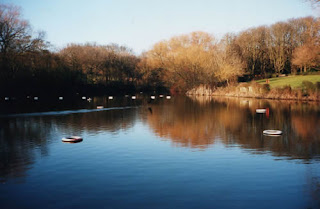
The Sedlec Ossuary is a small chapel located beneath the cemetery church of All Saints in the town of Sedlec, a suburb of the Bohemian town of Kutná Hora, Czech Republic. The ossuary is estimated to contain the skeletons of approximately 40,000 people; many of the skulls and bones were artistically arranged in the late 19th century to form decorations and furnishings for the chapel.
The cemetery of a 12th century Cistercian Monastery was for centuries a popular burial ground for people from all over Eastern Europe, because a thirteenth century abbot who returned from the Holy Lands sprinkled some earth he had gathered at Golgotha over the cemetery grounds. When the church had to be enlarged, a lower chapel was constructed to hold the skeletal remains of the thousands of bodies unearthed in mass graves on the property; many of these skeletons dated from the time of the plagues of the 14th century (approximately 30,000 victims were buried here) and the Hussite Wars of the early15th century. In 1420 Kutná Hora fell to Jan Zizka, leader of the Taborites, a sect of Hussite extremists.

The upper chapel was rebuilt in the early 18th century in Baroque style, but it was not until 1870, when Bohemia was part of the Austro-Hungarian Empire, that František Rint, a woodcarver, was employed by the Schwarzenberg family to put the stacks of human bones into some sort of order. The macabre result of his efforts speaks for itself. Four enormous bell-shaped mounds of bones occupy the corners of the chapel. A gigantic chandelier, which contains at least one of every bone in the human body, hangs from the center of the nave with garlands of skulls draping the vault. Other works include piers and monstrances flanking the altar, a large coat-of-arms of the noble German Schwarzenberg family, fashioned entirely from bones, and the signature of Rint, also executed in bone, on the wall near the entrance.

Kutná Hora, a town made fabulously wealthy from silver mining in medieval times, is about 45 miles southeast of Prague. In Kutná Hora, the flamboyant gothic church of St. Barbara is not to be missed. Sedlec is about two miles from the center of town; the ossuary is open daily except December 24 and 25. A small admission fee is charged.
In a close-up of the Schwarzenberg coat-of-arms, a "bird" plucks an eye from the head of a Turk; one of the Schwarzenberg counts conquered the Turkish occupied fortress of Raab (present day Győr, Hungary) in Renaissance times. This family made its home for several months of the year in Český Krumlov, in southwest Bohemia. Český Krumlov has become the second most visited Czech city after Prague.

Kutná Hora and the neighboring town of Sedlec are UNESCO World Heritage sites. Among the most important Kutná Hora buildings are the flamboyant Gothic St. Barbara's Church (photo below), begun in 1388, and the Italian Court, formerly a royal residence and mint, which was built at the end of the 13th century. Sedlec is the site of the Gothic Cathedral of Our Lady and the famous Ossuary.














































